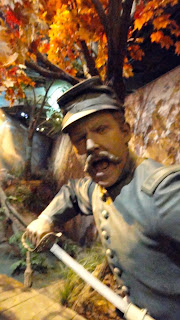 |
| National Infantry Museum. Photo © by Debi Lander. |
 |
| Follow me. Photo © by Debi Lander. |
 |
| A Merril's Marauder MSG Vincent Melillo. Photo © by Judy Wells. |
The first punch, walking into the "Last 100 Yards" exhibit, was a doozy. One hesitates to call it an "exhibit." The museum is filled with exhibits. This was a catharsis.
The infantry "owns" the last 100 yards of any battlefield; their job is to charge and engage the enemy, to defeat the enemy and to take and hold the ground. A circular opening symbolizing a drum leads to a gently sloping ramp.
Follow Me
 |
| Battle of Yorktown. Photo © by Debi Lander. |
 |
| Heads and bodies are those of today's Infantrymen. Photos © by Judy Wells. |
 |
| Battle of Antietam, Civil War. Photo © by Debi Lander. |
 |
| Battle of Soissons tableau. Photo © by Debi Lander. |
 |
| The 5th Ranger Battalion had to climb a 100-foot tall wall of stone to defeat the German artillery unit at Pointe du Hoc on Omaha Beach. Photo © by Debi Lander. |
 |
| Millett's bayonet attack. Photo © by Judy Wells. |
 |
| Assault on Landing Zone X-ray. Photo © by Debi Lander. |
 |
| Desert warfare. Photo © by Debi Lander. |
By this point the anecdotes began taking their toll. One day a group from Officers Candidate School came through, said Jim, and one tapped him on the shoulder. “I need to tell you something,” the man said, adding that he had been a medic on the battlefield that day. “I was the one who pulled them out and patched them up.” He began to tear up looking at the figure atop the Bradley. “The commander, he was a good friend. I couldn’t save him; he was too far gone.”
We were pretty far gone too when Jim told another about a class of fifth graders who came through. At this point a little girl began to cry loudly. “I didn’t know there were bad people in the world who wanted to hurt me, hurt my family,” she said between sobs. Two soldiers had been following the group and one came up to the girl, dropped on his knee, hugged her and said, “Honey, don’t worry. We are trained and we are here to protect you.”
Teary-eyed? You bet.
 |
| The parade ground and home of Sacred Soil. Photo © by Judy Wells. |
Sacred Soil
Leaving those last 100 yards you can see the Parade Grounds where new recruits graduate to infantrymen. You can't distinguish the Sacred Soil but it's there.March 19, 2009, descendants of soldiers who fought and died in the Army's battles scattered soil from those wars onto the parade grounds.
First to add Sacred Soil to the parade ground was Douglas Hamilton, a fifth generation descendant of Alexander Hamilton. He scattered soil from the Battle of Yorktown where Lieutenant Colonel Hamilton served.
Theodore Roosevelt IV could have participated twice in the ceremony - as great-grandson of President Theodore Roosevelt, who was awarded the Medal of Honor after the battle of San Juan Hill in the Spanish-American War, and as grandson of Theodore Roosevelt Jr., who earned the medal on D-Day - but he represented the veterans of the World War II European Theater with sand from the beaches of Normandy. The Pacific theater was represented by Kirk Davis, who earned the Medal of Honor with the infantry at Guadalcanal.
Honors for the Battle of Antietam in the Civil War were shared by Henry Benning Pease Jr., a descendant of Henry Lewis Benning, who commanded the Confederates at Burnside Bridge, and former Secretary of Interior Dirk Kempthorne, whose great-grandfather was a Union soldier wounded at Antietam.
Soil from Soissons, France, a major battle of World War I, was spread by Samuel Parker Moss whose grandfather, Samuel Parker, earned the Medal of Honor with the 28th Infantry and became that war's most decorated officer. He was joined by George York, son of Sgt. Alvin York.
Spreading soil from Korea were Medal of Honor winner Col. Ola Lee Mize, who fought at Outpost Harry, and Gen. Paik Sun-Yup, South Korea's most decorated veteran.
Adding soil from Vietnam were Gen. Hal Moore and Command Sgt. Major Basil Plumley, who fought in the first major battle there. Representing our current conflicts with soil from Iraq and Afghanistan was Command Sgt. Major Marvin Hill, senior enlisted adviser to Gen. David Petraeus.
From that day on, new infantrymen have marched over the soil of lands where their forefathers fought and died.
Shoot 'Em
 |
| The Good Girls NEVER pass up a costume opportunity like this one in the Family Gallery. |
 |
| We "fought" through a simulated battle. |
It would take you at least 16 hours to see everything here so the Good Girls figure we need three more be-back days. It would be well worth it.
- Post by Judy Wells


No comments:
Post a Comment